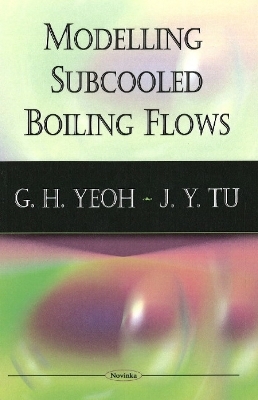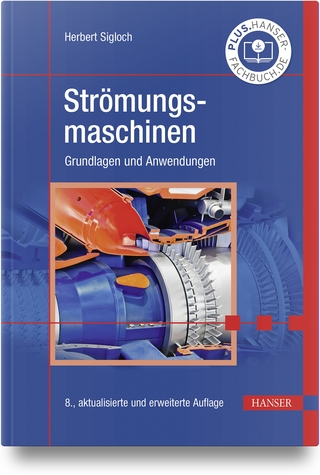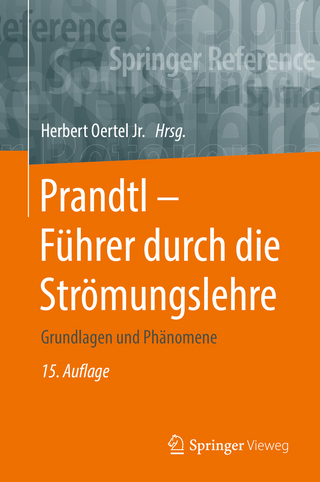
Modelling Subcooled Boiling Flows
Seiten
2008
Nova Science Publishers Inc (Verlag)
978-1-60456-943-8 (ISBN)
Nova Science Publishers Inc (Verlag)
978-1-60456-943-8 (ISBN)
In the context of computational fluid dynamics (CFD), modelling low-pressure subcooled boiling flow is of particular significance. This book provides a review of the various numerical modelling approaches that have been adopted to handle subcooled boiling flow.
In the context of computational fluid dynamics (CFD), modelling low-pressure subcooled boiling flow is of particular significance. A review is provided in this book of the various numerical modelling approaches that have been adopted to handle subcooled boiling flow. The main focus in the analysis of such a challenging problem can be broadly classified according into two important categories: (i) Heat transfer and wall heat flux partitioning during subcooled boiling flow at the heated wall and (ii) Two-phase flow and bubble behaviours in the bulk subcooled flow away from the heated wall. For the first category, details of both empirical and mechanistic models that have been proposed in the literature are given. The enhancement in heat transfer during forced convective boiling attributed by the presence of both sliding and stationary bubbles, force balance model for bubble departure and bubble lift-off as well as the evaluation of bubble frequency based on fundamental theory depict the many improvements that have been introduced to the current mechanistic model of heat transfer and wall heat flux partitioning. For the second category, details of applications of various empirical relationships and mechanistic model such as population balance model to determine the local bubble diameter in the bulk subcooled liquid that have been employed in the literature are also given. A comparison of the predictions with experimental data is demonstrated. For the local case, the model considering population balance and improved wall heat partition shows good agreement with the experimentally measured radial distributions of the Sauter mean bubble diameter, void fraction, interfacial area concentration and liquid velocity profiles. Significant weakness prevails however over the vapor velocity distribution. For the axial case, good agreement is also achieved for the axial distributions of the Sauter mean bubble diameter, void fraction and interfacial area concentration profiles. The present model correctly represents the plateau at the initial boiling stages at upstream, typically found in low-pressure subcooled boiling flows, followed by the significant rise of the void fraction at downstream.
In the context of computational fluid dynamics (CFD), modelling low-pressure subcooled boiling flow is of particular significance. A review is provided in this book of the various numerical modelling approaches that have been adopted to handle subcooled boiling flow. The main focus in the analysis of such a challenging problem can be broadly classified according into two important categories: (i) Heat transfer and wall heat flux partitioning during subcooled boiling flow at the heated wall and (ii) Two-phase flow and bubble behaviours in the bulk subcooled flow away from the heated wall. For the first category, details of both empirical and mechanistic models that have been proposed in the literature are given. The enhancement in heat transfer during forced convective boiling attributed by the presence of both sliding and stationary bubbles, force balance model for bubble departure and bubble lift-off as well as the evaluation of bubble frequency based on fundamental theory depict the many improvements that have been introduced to the current mechanistic model of heat transfer and wall heat flux partitioning. For the second category, details of applications of various empirical relationships and mechanistic model such as population balance model to determine the local bubble diameter in the bulk subcooled liquid that have been employed in the literature are also given. A comparison of the predictions with experimental data is demonstrated. For the local case, the model considering population balance and improved wall heat partition shows good agreement with the experimentally measured radial distributions of the Sauter mean bubble diameter, void fraction, interfacial area concentration and liquid velocity profiles. Significant weakness prevails however over the vapor velocity distribution. For the axial case, good agreement is also achieved for the axial distributions of the Sauter mean bubble diameter, void fraction and interfacial area concentration profiles. The present model correctly represents the plateau at the initial boiling stages at upstream, typically found in low-pressure subcooled boiling flows, followed by the significant rise of the void fraction at downstream.
Preface; Nomenclature; Introduction; Conservation Equations for the Two-Fluid Boiling Model; Application of Empirical Relationships to Modeling Subcooled Boiling Flow; Phenomenological Observations and Population Balance Model; Improvements to Wall Heat Flux Partitioning Mode; Conclusion; Index.
| Erscheint lt. Verlag | 1.10.2008 |
|---|---|
| Zusatzinfo | Illustrations |
| Verlagsort | New York |
| Sprache | englisch |
| Maße | 215 x 140 mm |
| Gewicht | 184 g |
| Themenwelt | Naturwissenschaften ► Physik / Astronomie ► Strömungsmechanik |
| ISBN-10 | 1-60456-943-3 / 1604569433 |
| ISBN-13 | 978-1-60456-943-8 / 9781604569438 |
| Zustand | Neuware |
| Haben Sie eine Frage zum Produkt? |
Mehr entdecken
aus dem Bereich
aus dem Bereich


